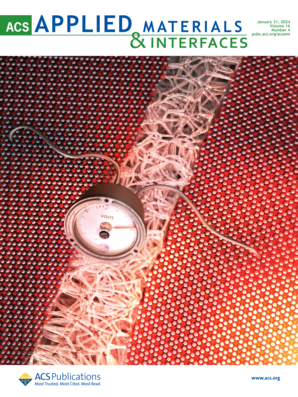Synergistic Cu2O@Ni(OH)2 Core–Shell Electrocatalyst for High-Efficiency Nitrate Reduction to Ammonia
IF 8.3
2区 材料科学
Q1 MATERIALS SCIENCE, MULTIDISCIPLINARY
引用次数: 0
Abstract
The electrocatalytic reduction reaction of nitrate (NO3RR) is anticipated to convert nitrogen-containing pollutants into valuable ammonia products. Copper-based catalysts have received great attention because of their good performance in the NO3RR due to the strong binding energy with *NO3 intermediates. However, the poor H2O dissociation ability of Cu is unable to provide H• in time for the hydrogenation reaction of NOx, thus hindering the electroreduction of the NO3–. Herein, we designed a shell–core nanocube electrocatalyst Cu2O@Ni(OH)2-x (x represents the molar ratio of Ni/Cu) using the liquid phase reduction combined with the etching and precipitation method for electrocatalytic NO3RR. Due to the synergistic effect between the strong nitrate activation ability of Cu and the excellent H2O dissociation ability of Ni(OH)2, Cu2O@Ni(OH)2-3.3% shows an impressive ammonia yield rate (557.9 μmol h–1 cm–2) and Faradaic efficiency (97.4%) at −0.35 V vs. RHE. Operando Raman and Auger electron spectroscopy observe the reduction of Cu2O to Cu during the NO3RR process. Density functional theory calculations combined with electron paramagnetic resonance analysis reveals that Ni(OH)2 can lower the activation energy barrier of H2O dissociation, thereby promoting the generation of H• and accelerating the hydrogenation of *NO during the NO3RR. This research provides an efficient Cu-based catalyst for reducing NO3– and may motivate the development of effective ammonia electrocatalysts for further experimentation.

协同Cu2O@Ni(OH)2核壳电催化剂用于硝酸高效还原制氨
硝酸钾电催化还原反应可将含氮污染物转化为有价氨产物。铜基催化剂由于与*NO3中间体具有较强的结合能,在NO3RR中表现良好,受到了广泛的关注。但Cu的H2O解离能力差,无法及时为NOx的加氢反应提供H•,从而阻碍了NO3 -的电还原。本文采用液相还原法结合蚀刻沉淀法设计了一种壳核纳米立方电催化剂Cu2O@Ni(OH)2-x (x表示Ni/Cu的摩尔比),用于电催化NO3RR。由于Cu强大的硝酸盐活化能力和Ni(OH)2优异的水解离能力之间的协同作用,Cu2O@Ni(OH)2-3.3%在−0.35 V下与RHE相比,氨收率达到557.9 μmol h-1 cm-2,法拉第效率达到97.4%。Operando拉曼和俄歇电子能谱观察了NO3RR过程中Cu2O还原为Cu的过程。密度泛函理论计算结合电子顺磁共振分析表明,在NO3RR过程中,Ni(OH)2可以降低H2O解离的活化能垒,从而促进H•的生成,加速*NO的加氢。本研究提供了一种高效的cu基还原NO3 -催化剂,并为进一步实验提供了有效的氨电催化剂的发展动力。
本文章由计算机程序翻译,如有差异,请以英文原文为准。
求助全文
约1分钟内获得全文
求助全文
来源期刊

ACS Applied Materials & Interfaces
工程技术-材料科学:综合
CiteScore
16.00
自引率
6.30%
发文量
4978
审稿时长
1.8 months
期刊介绍:
ACS Applied Materials & Interfaces is a leading interdisciplinary journal that brings together chemists, engineers, physicists, and biologists to explore the development and utilization of newly-discovered materials and interfacial processes for specific applications. Our journal has experienced remarkable growth since its establishment in 2009, both in terms of the number of articles published and the impact of the research showcased. We are proud to foster a truly global community, with the majority of published articles originating from outside the United States, reflecting the rapid growth of applied research worldwide.
 求助内容:
求助内容: 应助结果提醒方式:
应助结果提醒方式:


